Intersecting-Contact Sealing Mechanism Analysis and Experimental Investigation of Pressure-Preserved Coring Controller in Deep Coal Seams
Abstract
1. Introduction
2. Working Principle of Pressure-Preserved Coring
2.1. Structure and Principle of Pressure-Preserved Coring System
2.2. Design Requirements for Pressure Controller
2.3. Geometric Configuration Design of Pressure Controller
3. Spatial Motion Analysis of the Pressure Controller During Seal Formation
3.1. Geometric Model Construction of Sealing Interface Geometric Model Construction
3.2. Spatial Motion Process of Sealing Interface
4. Study on Sealing Mechanism of Pressure Controller
4.1. Finite Element Model Construction
4.2. Contact Characteristic Analysis
4.3. Load Bearing Characteristic Analysis
5. Laboratory Testing and Experimentation
5.1. Experimental Plan
5.2. Result Analysis
6. Conclusions
Author Contributions
Funding
Institutional Review Board Statement
Informed Consent Statement
Data Availability Statement
Conflicts of Interest
References
- Xie, H.; Lu, J.; Li, C.; Li, M.; Gao, M. Experimental study on the mechanical and failure behaviors of deep rock subjected to true triaxial stress: A review. Int. J. Min. Sci. Technol. 2022, 23, 915–950. [Google Scholar] [CrossRef]
- Zhou, H.; Lu, M.; Xie, H.; Jia, W.; Peng, R.; Wang, Y.; Chen, B.; Jing, P. Numerical analysis on mechanical difference of sandstone under in-situ stress, pore pressure preserved environment at depth. Int. J. Min. Sci. Technol. 2023, 33, 1339–1350. [Google Scholar] [CrossRef]
- Xie, H. Research review of the state key research development program of China: Deep rock mechanics and mining theory. J. China Coal Soc. 2019, 44, 1283–1305. (In Chinese) [Google Scholar] [CrossRef]
- Akdaş, S.B.; Fişne, A. A data-driven approach for the prediction of coal seam gas content using machine learning techniques. Appl. Energy 2023, 347, 121499. [Google Scholar] [CrossRef]
- Ruiyue, Y.; Chunyang, H.; Zhongwei, H.; Xianzhi, S.; Haitao, W. Coal breakage using abrasive liquid nitrogen jet and its implications for coalbed methane recovery. Appl. Energy 2019, 253, 113485. [Google Scholar] [CrossRef]
- Abhijit, M.; Satya, H.; Shimin, L. Laboratory measurement and modeling of coal permeability with continued methane production: Part 1—Laboratory results. Fuel 2012, 94, 110–116. [Google Scholar] [CrossRef]
- Wang, Y.; Kang, J.; Zhou, F. Evaluation of lost gas in the borehole drilling stage: Implication for the direct method of coalbed methane content determination. J. Nat. Gas Sci. Eng. 2022, 105, 104711. [Google Scholar] [CrossRef]
- Li, J.; Lu, S.; Zhang, P.; Cai, J.; Li, W.; Wang, S.; Feng, W. Estimation of gas-in-place content in coal and shale reservoirs: A process analysis method and its preliminary application. Fuel 2020, 259, 116266. [Google Scholar] [CrossRef]
- Li, J.; Xie, H.; Li, J.; Wang, T.; Liu, G.; Gao, M.; Zhang, Z. A lightweight pressure- and gas-preserved coring tool for accurate gas content measurement in deep coal seams. J. Clean. Prod. 2025, 501, 145230. [Google Scholar] [CrossRef]
- Li, J.; Li, J.; Wang, T.; Shi, X.; Cui, P.; Shang, D. Development and validation of a remotely triggered pressureand gas-preserved coring tool for deep coal mines in drilling fluid environments. Adv. Geo-Energy Res. 2024, 14, 147–160. [Google Scholar] [CrossRef]
- Zhao, S.; Lu, S.; Wu, J.; Li, W.; Liu, Y.; Li, J.; Zhang, J.; Xia, Z.; Huang, S. Comparison and Verification of Gas-Bearing Parameter Evaluation Methods for Deep Shale Based on the Pressure Coring Technique. Energy Fuels 2023, 37, 2066–2077. [Google Scholar] [CrossRef]
- Fulthorpe, C.S.; Miller, K.G.; Droxler, A.W.; Hesselbo, S.P.; Camoin, G.F.; Kominz, M.A. Drilling to Decipher Long-Term Sea-Level Changes and Effects A Joint Consortium for Ocean Leadership, ICDP, IODP, DOSECC, and Chevron Workshop. Sci. Drill. 2008, 6, 19–28. [Google Scholar] [CrossRef]
- He, S.; Peng, Y.; Jin, Y.; Wan, B.; Liu, G. Review and Analysis of Key Techniques in Marine Sediment Sampling. Chin. J. Mech. Eng. 2020, 33, 160–176. [Google Scholar] [CrossRef]
- Pape, T.; Hohnberg, H.J.; Wunsch, D.; Anders, E.; Freudenthal, T.; Huhn, K.; Bohrmann, G. Design and deployment of autoclave pressure vessels for the portable deep-sea drill rig MeBo (Meeresboden-Bohrgert). Sci. Drill. 2017, 23, 29–37. [Google Scholar] [CrossRef]
- Schultheiss, P.J.; Francis, T.J.G.; Holland, M.; Roberts, J.A.; Amann, H.; Parkes, R.J.; Martin, D.; Rothfuss, M.; Tyunder, F.; Jackson, P.D. Pressure coring, logging and subsampling with the HYACINTH system. Geol. Soc. Lond. Spec. Publ. 2006, 267, 151–163. [Google Scholar] [CrossRef]
- Schultheiss, P.; Holland, M.; Humphrey, G. Wireline Coring and Analysis under Pressure: Recent Use and Future Developments of the HYACINTH System. Sci. Drill. 2009, 7, 44–50. [Google Scholar] [CrossRef]
- Abid, K.; Spagnoli, G.; Teodoriu, C.; Falcone, G. Review of pressure coring systems for offshore gas hydrates research. Underw. Technol. 2015, 33, 19–30. [Google Scholar] [CrossRef]
- Yang, L.; Su, Y.; Luo, J.; Sun, S. Development and application of GW−CP194−80A pressure−maintaining coring tool. Nat. Gas Ind. 2020, 40, 91–96. (In Chinese) [Google Scholar] [CrossRef]
- Guo, D.; Xie, H.; Gao, M.; Li, J.; He, Z.; Chen, L.; Li, C.; Zhao, L.; Wang, D.; Zhang, Y.; et al. In-situ pressure-preserved coring for deep oil and gas exploration: Design scheme for a coring tool and research on the in-situ pressure-preserving mechanism. Energy 2024, 286, 129519. [Google Scholar] [CrossRef]
- You, K.; Thomas, C.; Savage, A.; Cardona, A.; Flemings, P.; Murphy, Z.; O’Connell, J. Dissolved Methane Diffusion Drives Hydrate-Bearing Pressure Core Degradationduring Long-Term Storagein Water. Energy Fuels 2024, 38, 10879–10889. [Google Scholar] [CrossRef]
- Sahu, C.; Kumar, R.; Sangwai, J.S. Comprehensive Review on Exploration and Drilling Techniques for Natural Gas Hydrate Reservoirs. Energy Fuels 2020, 34, 11813–11839. [Google Scholar] [CrossRef]
- Sun, S.; Zhang, Q.; Zheng, K.; Long, W. Technology and equipment of sealed coring for accurate determination of coalbed gas content in ground well. J. China Coal Soc. 2020, 45, 2523–2530. (In Chinese) [Google Scholar] [CrossRef]
- Wang, F.; Luo, Y.; Liang, Y.; Peng, J.; Li, B. Sampling Methane-Bearing Coal Seams by Freezing Method: Coalbed Methane Desorption and Inhibition Characteristics Under Freezing Temperature. Nat. Resour. Res. 2020, 29, 1351–1360. [Google Scholar] [CrossRef]
- Xie, H.; Liu, T.; Gao, M.; Chen, L.; Zhou, H.; Ju, Y.; Gao, F.; Peng, X.; Li, X.; Peng, R.; et al. Research on in-situ condition preserved coring and testing systems. Pet. Sci. 2021, 18, 1840–1859. [Google Scholar] [CrossRef]
- Huang, W.; Li, J.; Liu, Z.; Yang, M.; You, Z.; Xie, H. Study of a low-disturbance pressure-preserving corer and its coring performance in deep coal mining conditions. Int. J. Min. Sci. Technol. 2023, 33, 1397–1410. [Google Scholar] [CrossRef]
- Li, X.; Zhang, X.; Ma, Y.; Tian, Y.; Han, Z.; Zhang, Y. Design and Experimental Study of an Improved Pressure Core Sampler for Marine Gas Hydrates. ACS Omega 2024, 9, 14977–14984. [Google Scholar] [CrossRef]
- Aljuboury, M.; Rizvi, J.; Grove, S.; Cullen, R. A numerical investigation of the sealing performance and the strength of a raised face metallic bolted flange joint. Int. J. Press. Vessel. Pip. 2020, 189, 104255. [Google Scholar] [CrossRef]
- Murtagian, G.R.; Fanelli, V.; Villasante, J.A.; Johnson, D.H.; Ernst, H.A. Sealability of Stationary Metal-to-Metal Seals. J. Tribol. 2004, 126, 591–596. [Google Scholar] [CrossRef]
- Haruyama, S.; Nurhadiyanto, D.; Choiron, M.A.; Kaminishi, K. Influence of surface roughness on leakage of new metal gasket. Int. J. Press. Vessel. Pip. 2013, 111, 146–154. [Google Scholar] [CrossRef]
- Teles, D.B.; Gouveia, S.M.; Clarke, T.G.R. Identification of leakage in ball valves by analysis of pressure and torque signatures in cyclical tests under critical operating conditions. Eng. Fail. Anal. 2020, 117, 104828. [Google Scholar] [CrossRef]
- Li, J.; Wang, J.; Hu, Y.; You, Z.; Xu, M.; Wang, Y.; Zou, Z.; Kang, Q. Contact performance analysis of pressure controller’s sealing interface in deep in-situ pressure-preserved coring system. Pet. Sci. 2022, 19, 1334–1346. [Google Scholar] [CrossRef]
- Li, C.; Xie, H.; Gao, M.; Chen, L.; Zhao, L.; Li, C.; Wu, N.; He, Z.; Li, J. Novel designs of pressure controllers to enhance the upper pressure limit for gas-hydrate-bearing sediment sampling. Energy 2021, 227, 120405. [Google Scholar] [CrossRef]
- Garfield, G.; Mackenzie, G. Zonal Isolation Applications Utilizing New Metal-To-Metal Sealing Technology Demonstrates Potential For Offshore And Deepwater Environments. In Proceedings of the Offshore Mediterranean Conference and Exhibition, Ravenna, Italy, 28 March 2007; p. OMC-2007-163. Available online: https://onepetro.org/OMCONF/proceedings-pdf/OMC07/OMC07/OMC-2007-163/1833024/omc-2007-163.pdf (accessed on 14 November 2025).
- Dong, X.; Zhou, F.; Jiang, W.; Xie, Y.; Zhang, Y.; Xie, X.; Zhai, X.; Lu, C.; Li, G.; Jiang, X. Failure analysis of the conical gaskets in ultra-high pressure pipeline sealing devices: Experiment and numerical simulation. Eng. Fail. Anal. 2022, 133, 105946. [Google Scholar] [CrossRef]
- Inose, K.; Sugino, M.; Sugimura, J. Fundamental Evaluation of Sealability of Greased Metal-to-Metal Seal on Premium Threaded Joints at High Pressure and High Temperature. Tribol. Online 2021, 16, 192–198. [Google Scholar] [CrossRef]
- Timelli, G.; Mori, A.D.; Haghayeghi, R. Reliability of a high-pressure die cast Al alloy radiator. Eng. Fail. Anal. 2019, 105, 87–97. [Google Scholar] [CrossRef]



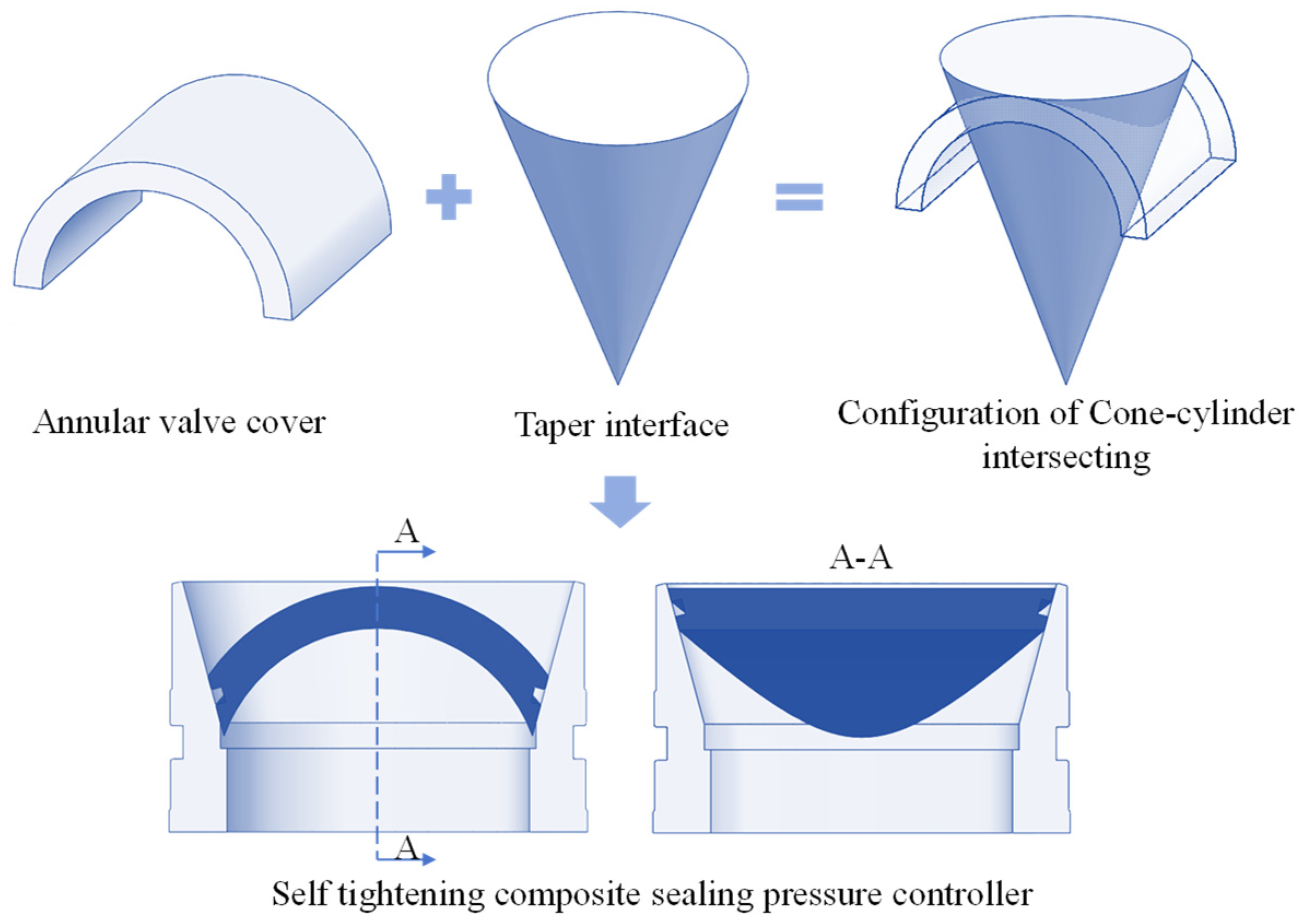

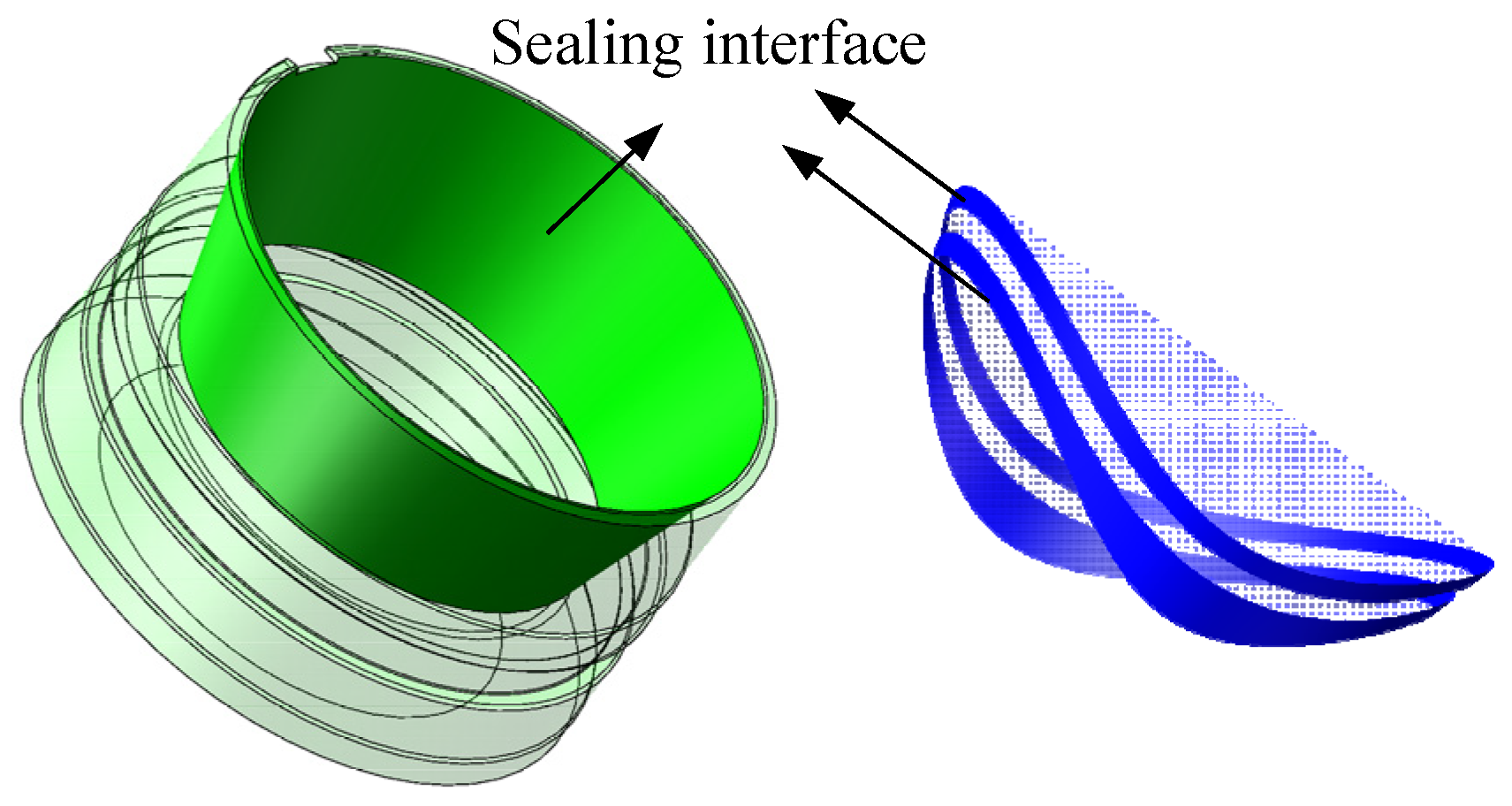
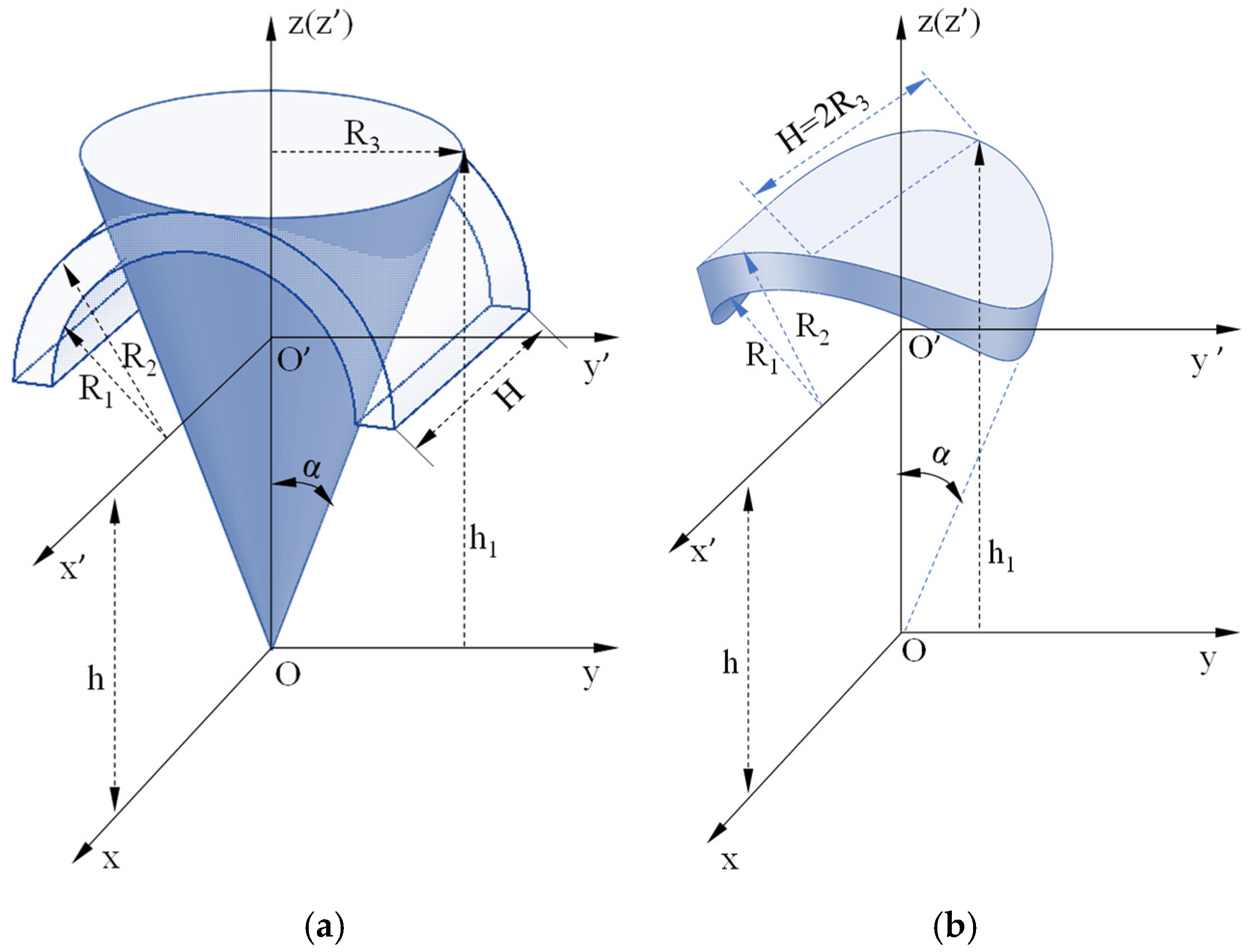
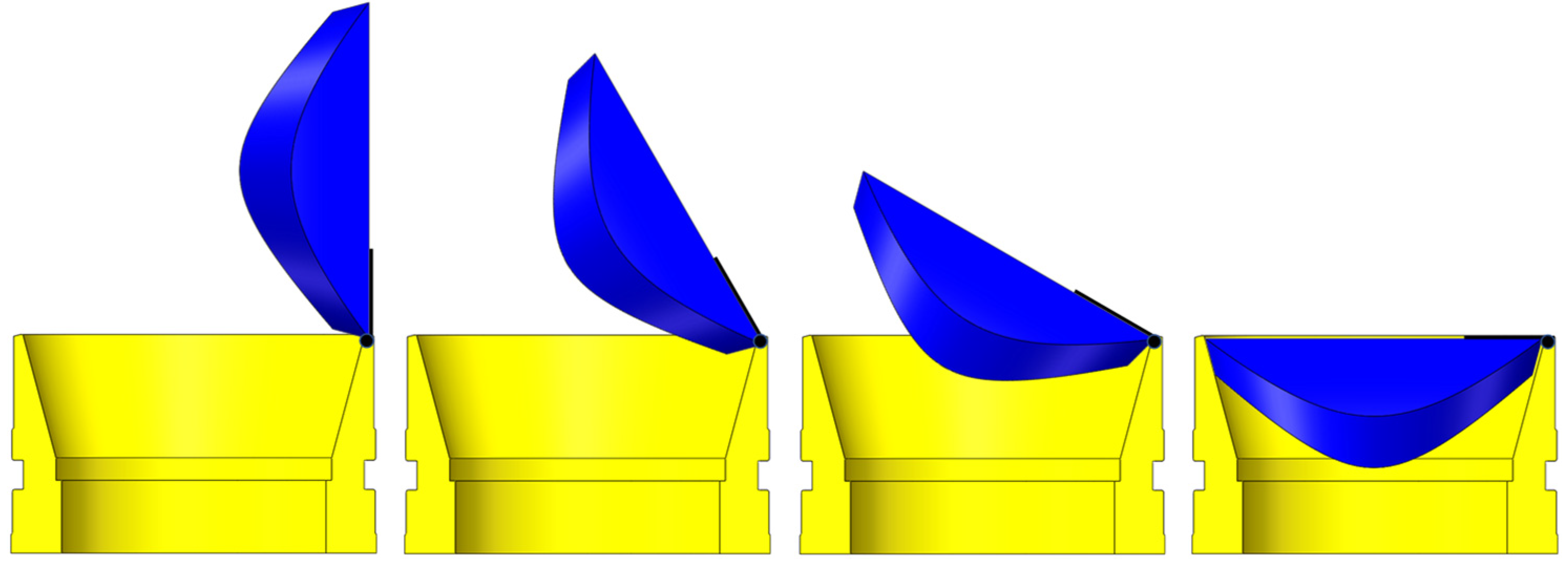

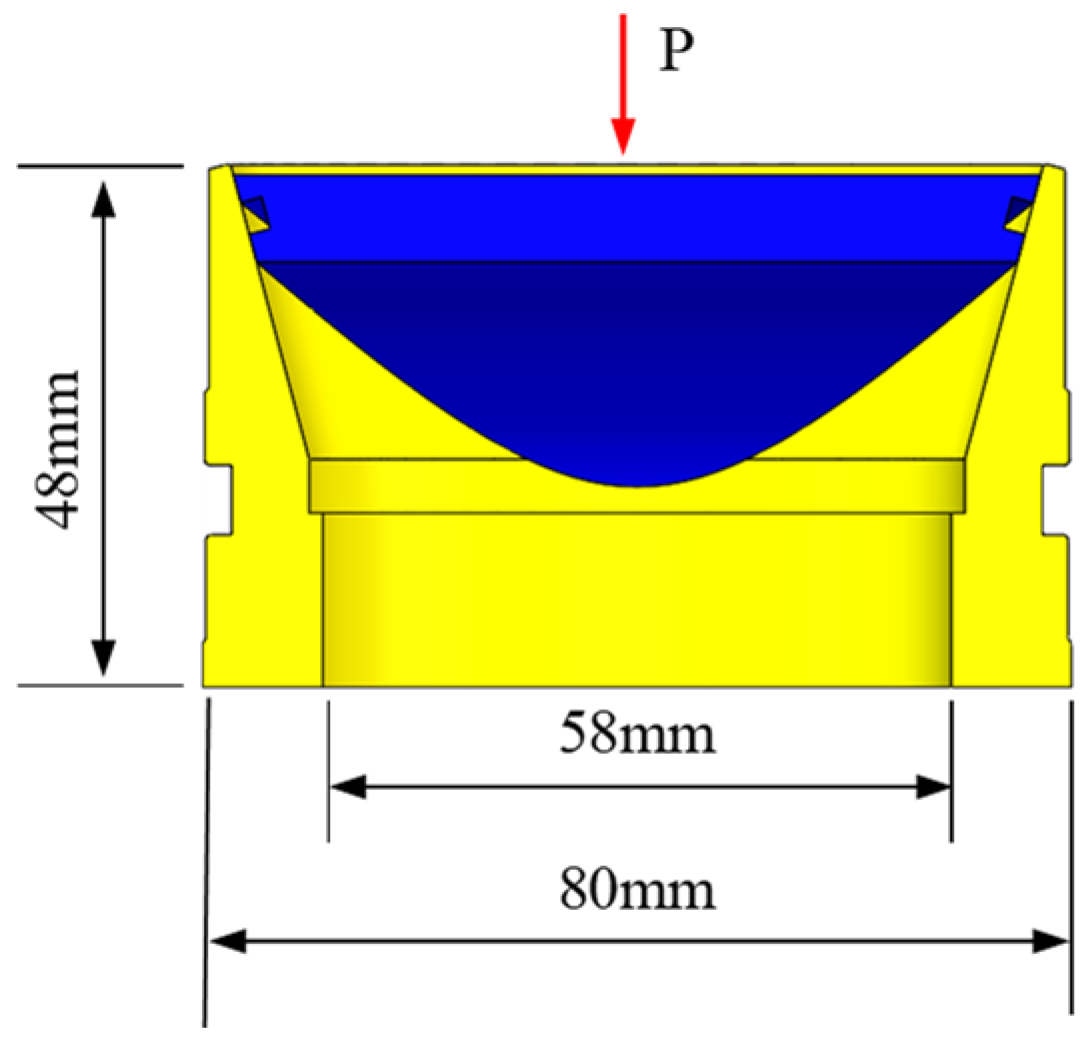



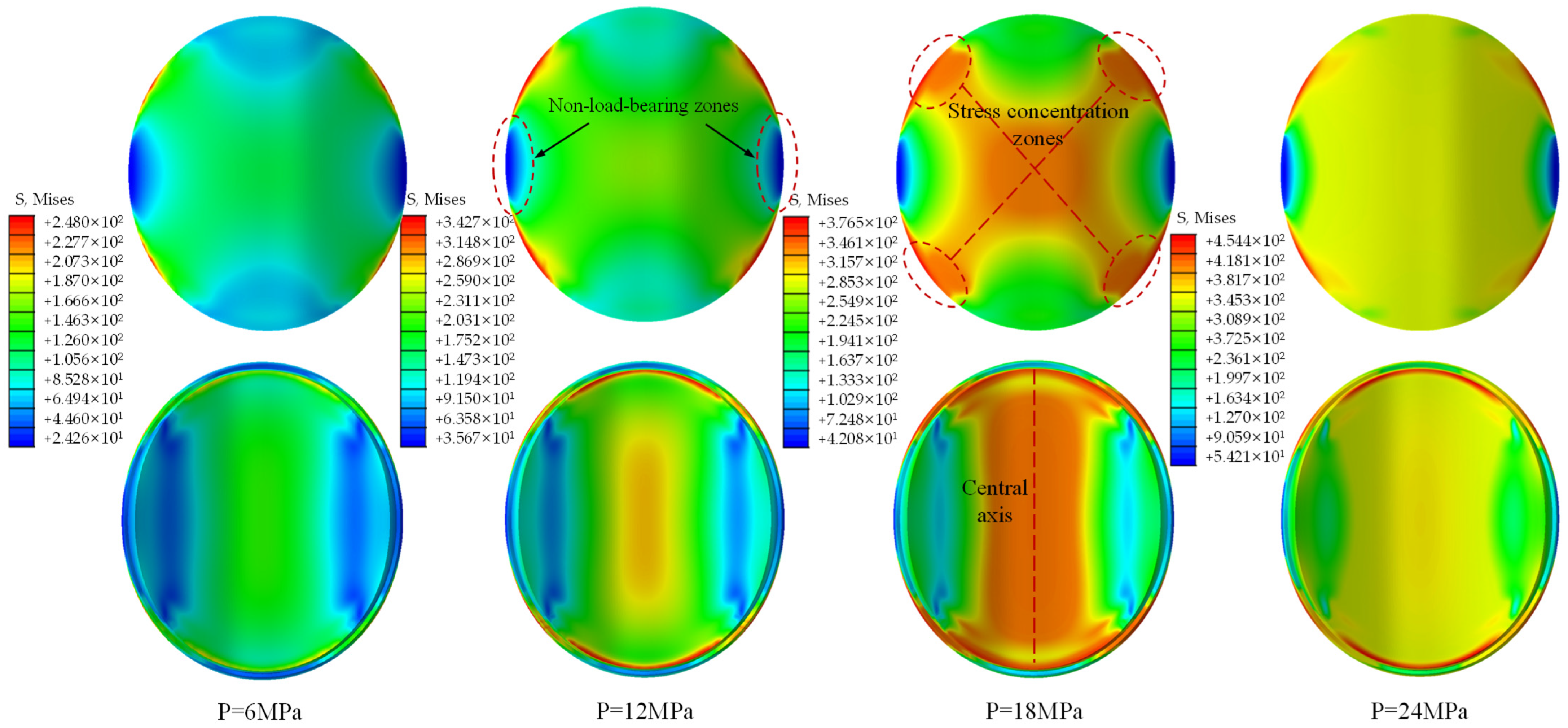



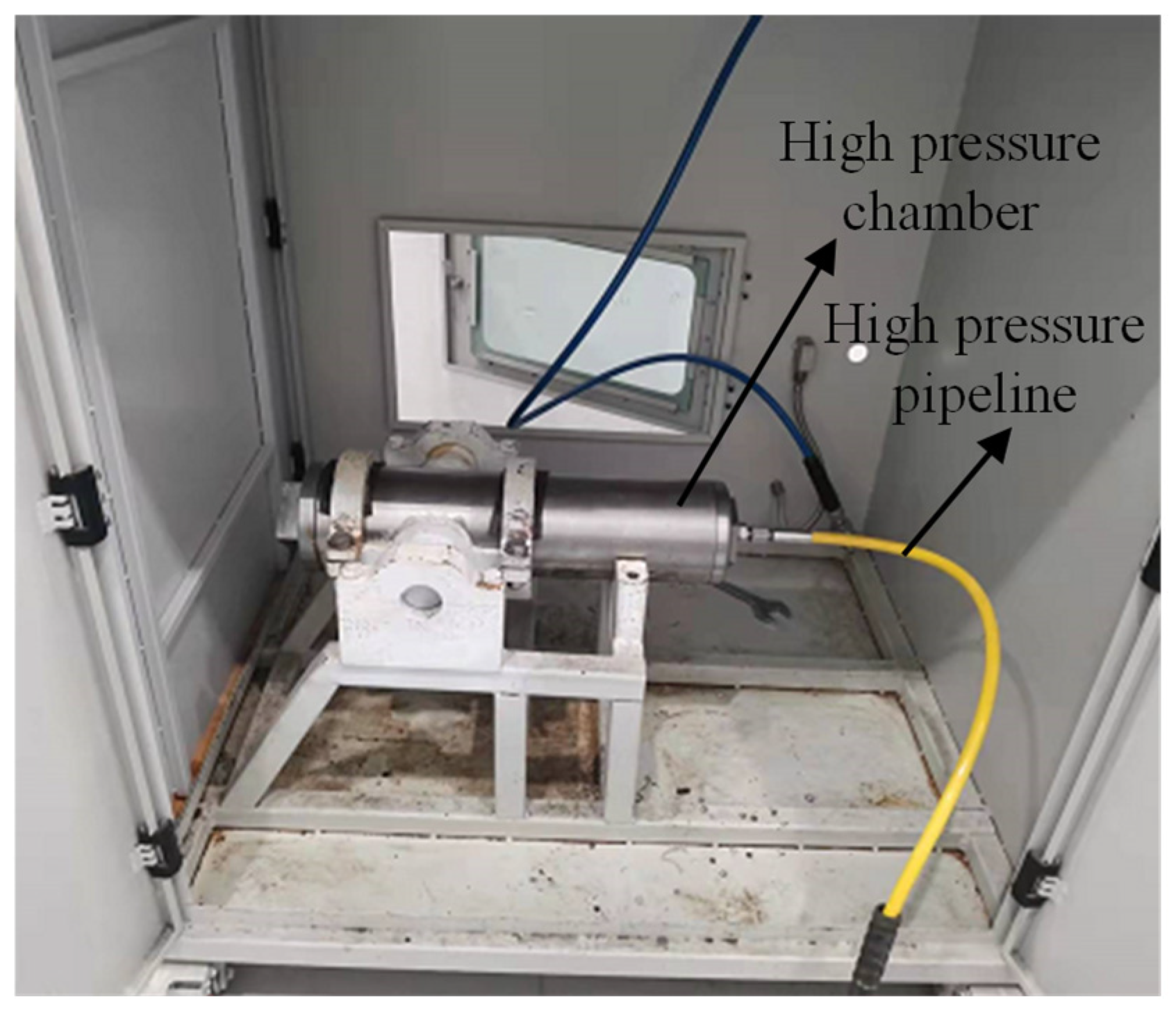
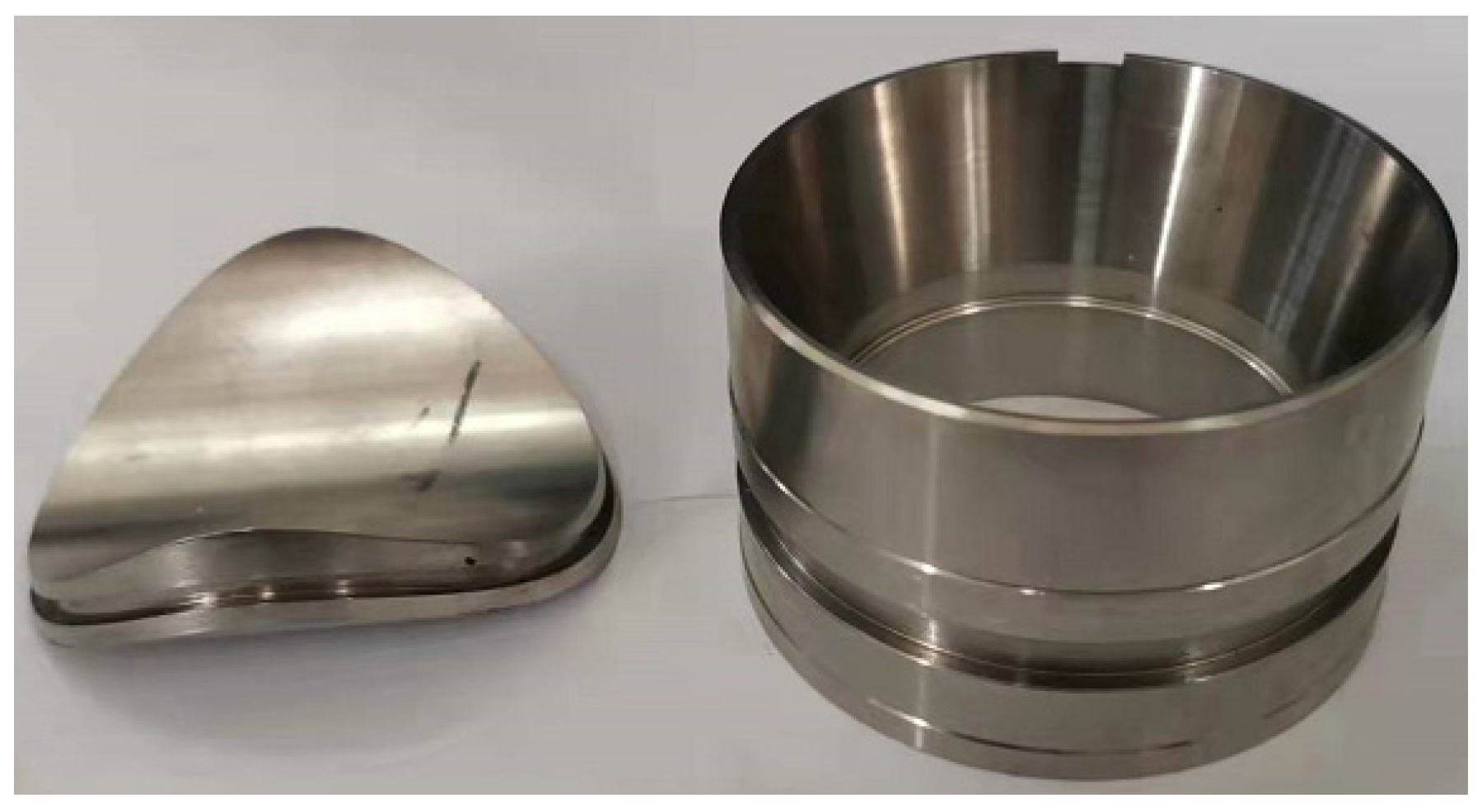
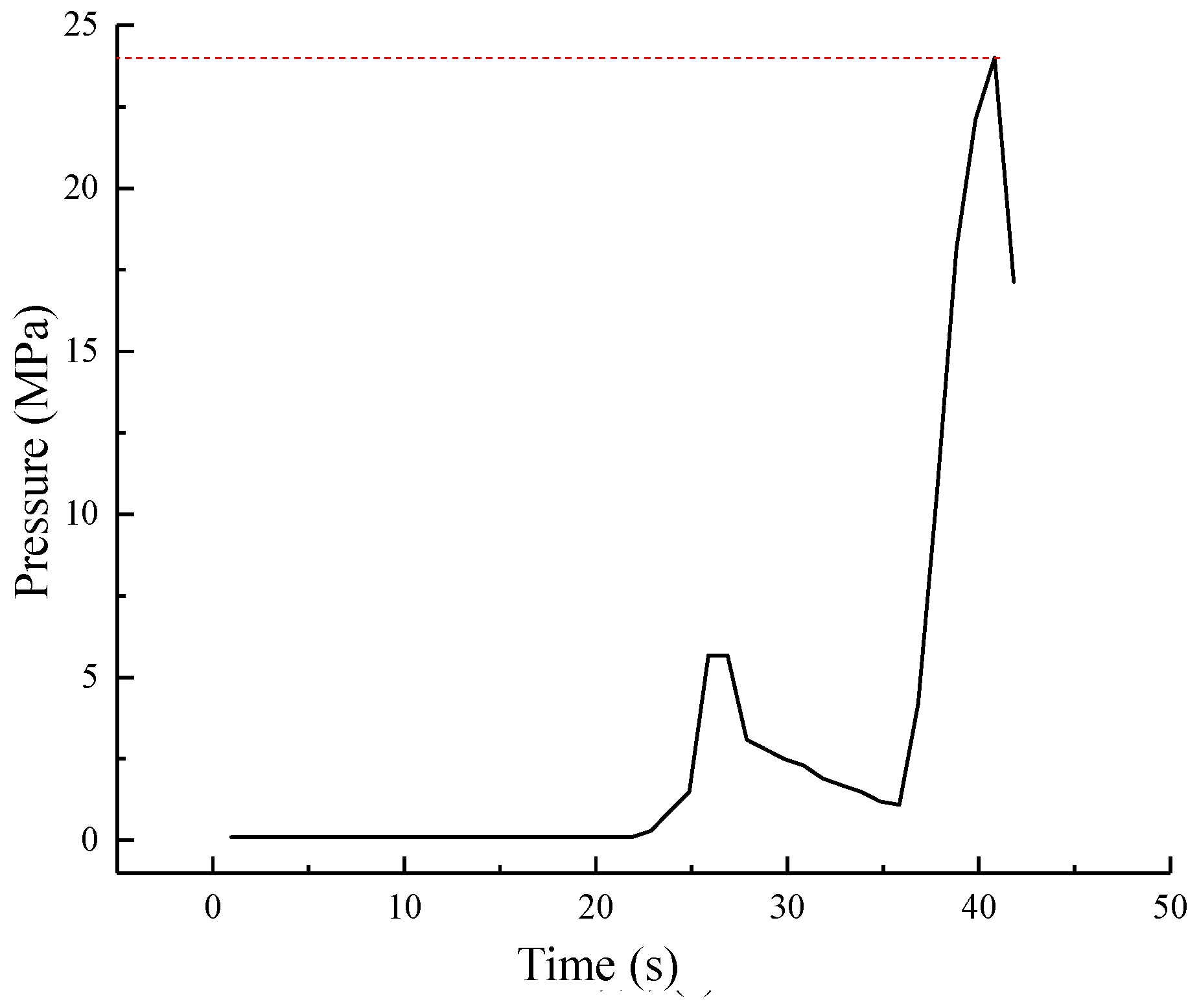




| Material | Elastic Modulus | Poisson’s Ratio | Yield Strength | Boundary Type | Element Type |
|---|---|---|---|---|---|
| AISI 304 | 195 GPa | 0.3 | 329 MPa | Symmetric boundary | C3D8R |
| Pressure load (MPa) | 6 | 12 | 18 | 24 | 27 | 30 |
| Displacement (mm) | 0.049 | 0.1 | 0.162 | 0.326 | 0.857 | 2.261 |
Disclaimer/Publisher’s Note: The statements, opinions and data contained in all publications are solely those of the individual author(s) and contributor(s) and not of MDPI and/or the editor(s). MDPI and/or the editor(s) disclaim responsibility for any injury to people or property resulting from any ideas, methods, instructions or products referred to in the content. |
© 2025 by the authors. Licensee MDPI, Basel, Switzerland. This article is an open access article distributed under the terms and conditions of the Creative Commons Attribution (CC BY) license (https://creativecommons.org/licenses/by/4.0/).
Share and Cite
Li, J.; Li, C.; Zhao, L.; Li, J.; You, Z.; Zhang, Z. Intersecting-Contact Sealing Mechanism Analysis and Experimental Investigation of Pressure-Preserved Coring Controller in Deep Coal Seams. Appl. Sci. 2025, 15, 12227. https://doi.org/10.3390/app152212227
Li J, Li C, Zhao L, Li J, You Z, Zhang Z. Intersecting-Contact Sealing Mechanism Analysis and Experimental Investigation of Pressure-Preserved Coring Controller in Deep Coal Seams. Applied Sciences. 2025; 15(22):12227. https://doi.org/10.3390/app152212227
Chicago/Turabian StyleLi, Jianan, Cong Li, Le Zhao, Ju Li, Zhenxi You, and Zetian Zhang. 2025. "Intersecting-Contact Sealing Mechanism Analysis and Experimental Investigation of Pressure-Preserved Coring Controller in Deep Coal Seams" Applied Sciences 15, no. 22: 12227. https://doi.org/10.3390/app152212227
APA StyleLi, J., Li, C., Zhao, L., Li, J., You, Z., & Zhang, Z. (2025). Intersecting-Contact Sealing Mechanism Analysis and Experimental Investigation of Pressure-Preserved Coring Controller in Deep Coal Seams. Applied Sciences, 15(22), 12227. https://doi.org/10.3390/app152212227






